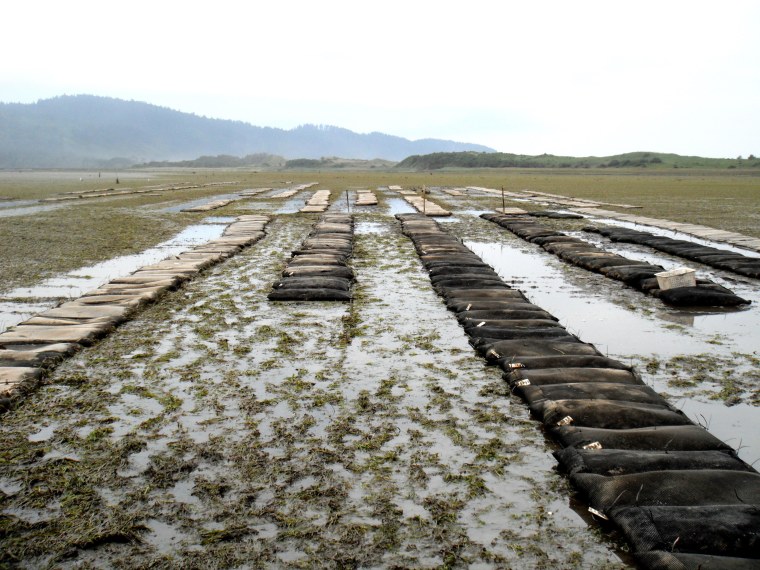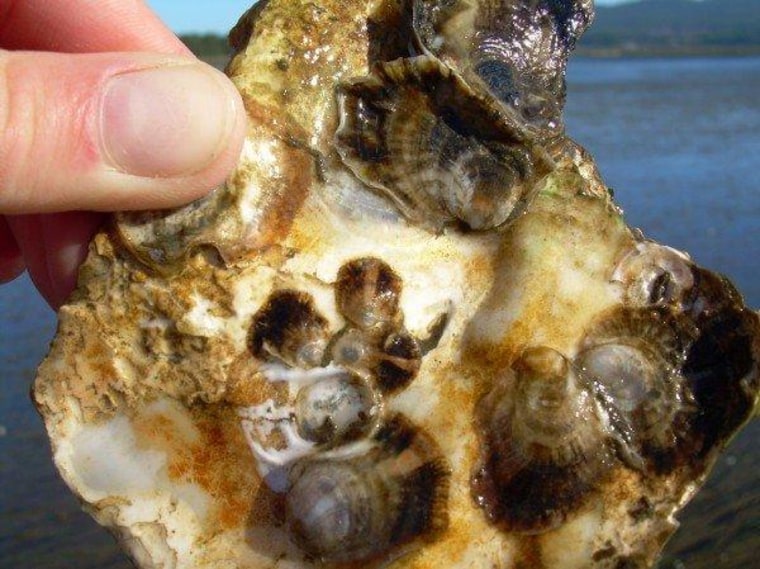
Oyster hatcheries are dropping the equivalent of Tums and other antacids into water to make it easier for naked mollusk larvae to build their shells. The remedy is working, for now, to keep hatcheries in business and oyster bars well stocked with the slimy delicacies, a hatchery scientist said.
Heartburn for the shellfish industry comes from ocean waters turning ever more corrosive as they absorb a fraction of the carbon dioxide humans are pumping into the atmosphere. The acidification, in turn, makes it harder for oyster larvae to build their shells.
The hatcheries' antacid, sodium carbonate, makes the water less acidic and "raises the amount of carbonate in the water, which is what the shellfish are using," Benoit Eudeline, the chief hatchery scientist at Taylor Shellfish Company in Quilcene, Wash., told NBC News.
Prior to the antacid solution, larvae survival rates at the hatchery had dropped between 60 and 80 percent by 2009 due to acidification from greenhouse gas pollution — as well as runoff from farms and sewage tanks — into the narrow bay where the hatchery is located.
The runoff triggers blooms of algae that release carbon dioxide into the water when the plants die, sink to the ocean floor and decay. Larvae survival rates were impacted most on days when this more corrosive water rose toward the surface and into the hatchery's intake pipes.
Scientists observed that the larvae were most sensitive to these more corrosive waters in the first few days after fertilization. New research published Tuesday in the journal Geophysical Research Letters provides "the direct evidence to explain why," George Waldbusser, a marine ecologist at Oregon State University and the study's lead author, told NBC News.
Larvae "have to make a lot of shell very quickly," he said. In their first two days, Pacific oyster larvae will precipitate roughly 90 percent of their body weight as calcium carbonate shell, and they do it with energy derived from the egg since, at this point, they don’t yet have feeding organs. "They can basically run out of energy," he said. And the exhaustion can be long-lasting, even lethal.
After 48 hours, the larvae have built their shell and feeding organs, which allows them to obtain energy from their environment and gain more control over the chemistry needed for building shell, which is done from inside.

By this point, "they appear much more able to generate shell," said Waldbusser, "even when conditions are corrosive to some degree."
According to Eudeline, who was not part of the new research but has worked closely with Waldbusser and his colleagues, the new findings help explain why the first 48 hours has "a strong impact on how good the larvae will behave after day 14 or day 15."
The findings, he added, also help inform what Taylor Shellfish, along with other major oyster hatcheries such as Whiskey Creek in Oregon, do to supply oysters to an industry unable to rely on natural sets — free-spawning larvae that settle on oyster shells.
In Willapa Bay, in southwestern Washington, for example, natural sets have declined steeply in recent years due to acidification, forcing the growers there to rely more heavily on the hatcheries, Eudeline noted.
"If you get less natural set, then hatcheries are struggling to provide larvae to the customers, then overall you are getting a decline in seed availability," he explained. "And to some extent, in the last few years, we have seen this. The industry is really dependent on a pretty small amount of hatcheries."
Outside of the hatcheries, dealing with ocean acidification is an even larger challenge, noted Waldbusser
Steps include addressing runoff pollution from sources such as sewage and farms that lead to increased acidification, as well as restoring native sea grasses and shell beds that appear to have a natural, local antacid effect that is beneficial to larval growth, he noted.
"Ultimately, at some point," he added, "they have to be able to address the bigger global CO2 problem."
John Roach is a contributing writer to NBC News. To learn more about him, visit his website.